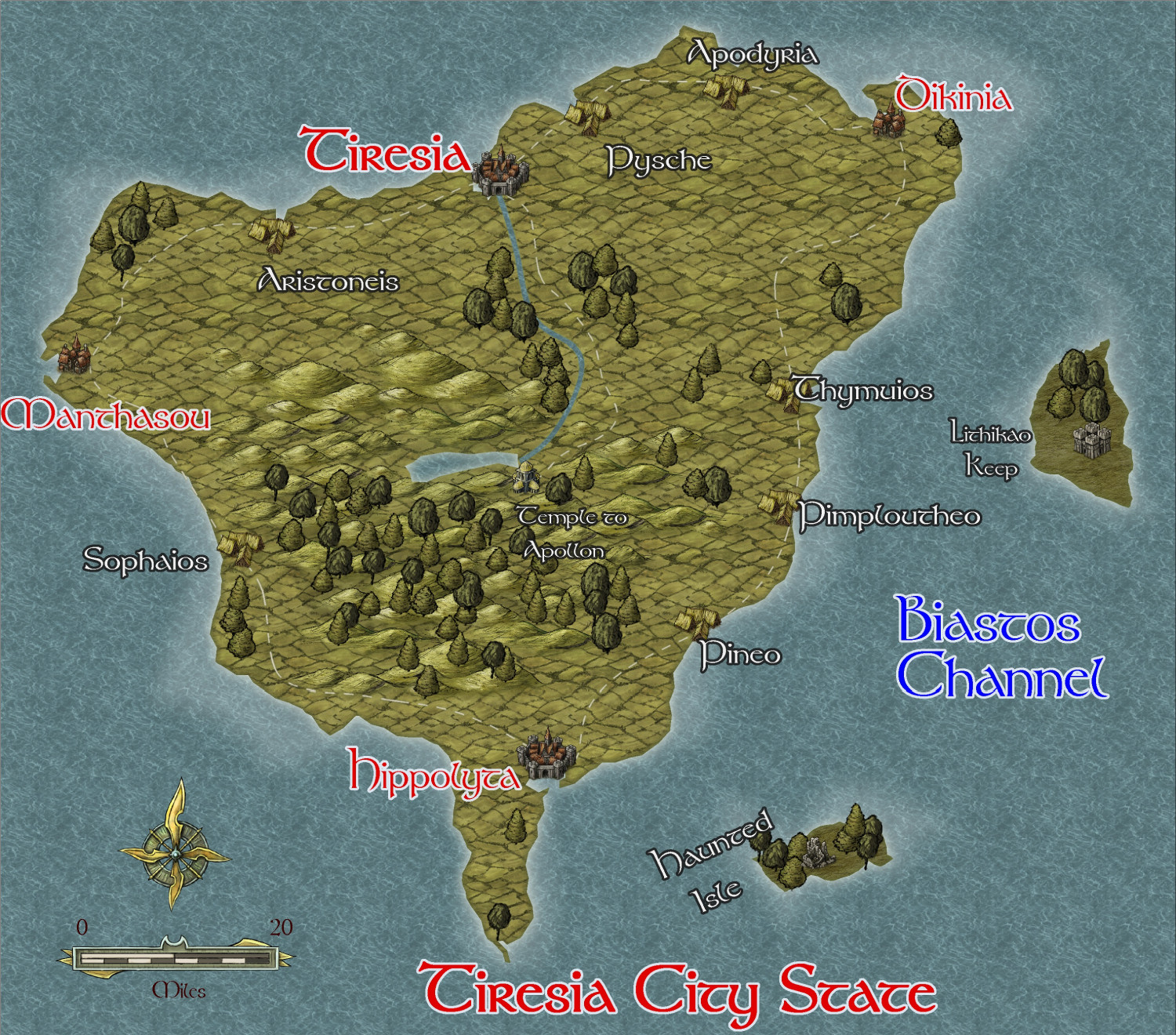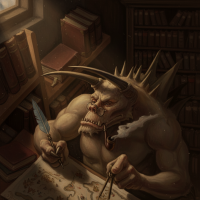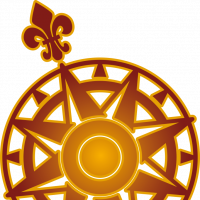Community Atlas - Irisian City States - Tiresia City State
I have decided to map all the islands in the irisian City map style while I am waiting to get my new computer back from the repairers under warranty. Since I have to send it to the manufacturers - overseas - it will only take 6 weeks - outrageous!!
Anyway, here is the first - the biggest of the remaining islands, Tiresia City State, which has hegemony over the whole island. It is mainly agricultural and fishing, and is the least wealthy of the City States. It is also the closest to the hostile Kingdom of Helmonte.
I am using the same style as I did for Helmonte - Herwin Wielink, not my favourite style by a long shot.
This is the beginning of the map - interesting features to be added later.







Comments
I think this is finished. I will write a map note, detailing mainly the potential adventure spots.
Please feel free to criticize and make suggestions.
Got bored! Here is the Haunted Island south-east of the main Isle of Tiresia.
Feel free to make suggestions, otherwise it is ready for the Atlas.
I have already made a few changes, but I will post the final map after people have had a chance to make suggestions. A good place to send orcs to.
The final map for Haunted Island.
The Map notes for the City State of Tiresia.
Tiresia City State
Tiresia is the smallest in power, both militarily, and economically, of the five Irisian City States. However, compared to the rest of Artemisia, it still ranks highly. The mainstay of the economy is agricultural, especially the olive oil industry, with a minor tin extraction industry. Most of the tin is exported to be refined elsewhere, with the State collecting both royalties, and a newly raised resources rent tac, to bolster the faltering economy of the City-State after a few years of devastating drought wrought havoc on the agricultural economy.
The olive oil industry is by far the most lucrative for the City-State, with large government holdings in one of the main Olive Oil companies, called The Popeye Oil Consortium. The purity, and special flavour of the oil is prized throughout Artemisia and beyond. The special flavour is imparted by pollinating bees of a unique kind, and causes the subsequent oil to have a faint honey-flavoured scent.
Tiresia is ruled by a Senate composed of 25 Senators, voted into office by all property holders with over 50,000 Drachmas in value ie only the wealthy families can vote. They then elect three Magisters, who hold office for three years, staggering the elections so that one is elected each year. This staggers the office holders so that the government is unusually stable, but also more likey to fall into corruption – which it has, leading as it does to a monopolization of power and wealth into the hands of a few families, a high level of corruption, (the highest of all the City-States), and a very unequal society.
Subsequently, demands from the rest of the populace, who cannot vote in any election, and have had their needs ignored for far too long, have grown stronger, accompanied by greater and greater civil unrest. The capital of Tiresia is most affected, but the more violent acts of arson, theft, destruction of government and senators’ private property, and abductions occur in the countryside, which has suffered extensively because of the three year drought. Various groups are calling for abolition of the Senate, replacement with an Assembly of the People and universal suffrage, including both genders, and a government headed by a directly elected Tribune. Finally, they are calling for trials of all corrupt officials – the one thing that sends tremors down the backbone of most of the Senate and government, and stiffens their resolve not to give an inch to those calling for change.
The increasingly radical and tense political situation has drawn the worried attention of the other City States, some of whom are wanting to send troops to quell the increasing unrest. However, Stromphe, the largest and most powerful of the City-States, has vetoed this and insists on non-interference. It is well-known that Stromphe, the least corrupt, and most democratic of the City-Sates, has contempt for the government of Tiresia, and would happily see it fall, and so extend their direct influence over the island. The other States, especially Otykos and Arete, have thus decided to keep their aid to an increasingly beleaguered government at the clandestine level, with moles in the radical groups, passing information to the Tiresian Magisters, and financial loans to the Senate to enable them to increase the ‘bread and circuses’ policy that they hope will have effect. Cake, rather than bread, is offered!
Unknown to all is that the mysterious Purple Daffodil (a rare bloom found in western Tiresia), leader of the most influential, and violent, of the groups calling for reforms, is in fact Demetrios Kaluthenas, younger son of one of the Magisters, Gerolimeo Kaluthenas. He seems motivated by a genuine disgust of the corruption of the present system, as well as anger at his treatment as an unwanted child by his authoritarian father. He has already drawn up a list of those he wants executed for corruption – and strangely, includes leading figures of the other three reformist groups. His own group is now the largest and most influential, and calls itself the Directorate of the People. His identity is known only by his closest friend, Brutos Skipianas, who is even more in favour of violent revolution than his leader. Not even Demetrios’ wife and children know of his true identity, and he plays the role of an incompetent fop and socialite very well. After every atrocity committed by the groups, and every murder or abduction, a purple daffodil is left as a sinister calling card.
The cycle of increasing violence and harsh counter-measures has the whole City-State ready to explode in violent revolution – and perhaps get beyond the control of even the manipulative Demetrios.
The religion of Tiresia, like that of all south and western Artemisia, is that of worship of the Olympian Gods, but especially Athea, Poseidon and Demeter. The clergy are calling for peaceful negotiations between the people and the Senate, but increasingly, their pleas are falling on deaf ears, and many of the would-be revolutionaries are casting the priests as fellow-travellers of the privileged classes.
The stage is set for events which may become world-shattering!
Further information on the City-State, indicating possible hooks for adventures. I may even map some of these at a lter date.
Sites of Interest
1. Circle of the Deep Old Ones: This double stone circle henge dates back thousands of years, presumably to mythical inhabitants of this region which have left mysterious ruins dotted over the whole of Artemisia. It has a fearsome reputation, where people have gone missing fo decades or lost forever, especially in recent times. In reality, it is the secret meeting place of one of the revolutionary groups, even more violent than the Directorate, though very much smaller. The recent disappearances have all been unfortunate travellers who ventured too close, and their bodies now lie stacked in the crypts below the central mound of the henge. And unknown to all is a portal to the dangerous portal in the borderlands between the Irisian City States and Themisia (see Hezla Fort Ruins).
2. Tower of Contemplation: This very old monastic structure was one of the earliest religious buildings in the whole of the southern region of Artemisia. It has unusual architecture, being a multi story edifice with each floor smaller than the floor below, with columns surrounding the roof of each level. At the top is an open area with an altar, bloodstained form past sacrifices. It is rumoured that even humans have been sacrificed here in times of need. And now there is talk of another human sacrifice in light of the devastating drought and political unrest. The Abbot is seriously considering sacrificing someone of importance, given the situation, and unforeseen by him, his deputy, who manipulated the Abbot into even considering a human sacrifice, has the Abbot himself slated for the victim.
3. Temple to Apollon: This is now a largely deserted Temple, as the worship of Apollon has declined, being replaced by that of Poseidon, Athena and Demeter. Only two old priests live there now, and still make weekly sacrifices to the God, although these are mainly wild birds caught in the nets of the old priests. Nearby is a hovel housing an elderly woman, who is really an avatar of Daphne, the nymph pursued by Apollon, who now seeks revenge on the God, and is the one responsible for the fall-off in the worship of the God, and has engineered the drought, despite Demeter’s half-hearted attempts to break the drought.
4. Nearby Caves: These caves near the Temple are the secret HQ of the Directorate, housing several dozen cadres-in-training, large weapon supplies, and a meeting place where many gather each week to plan and discuss forthcoming campaigns of disruption. Unfortunately for the Directorate, it has been infiltrated by an agent of the Senate, who any day is likely to divulge all the information he has on the Directorate, including the location of this secret hideaway. The reason he has not yet acted is because he himself now harbours doubts about the rightness of the Senate’s cause, having seen too much of the atrocities of the wealthy landowners. He measures this against the increasing violent and destructive acts of the Directorate, however, and also is desirous of obtaining a large reward for his information.
5. Gloom Swamp: This flea-ridden miasma is home to many birds and unusual plants – some poison, some medicinal. And it is also the home of an Amphibian monster, called Granthil, who has dragged many an unwary passer-by down to the murky depths of the swamp, and has even raided small farms nearby –, alas all now deserted and ravaged by time.
6. Lichikao Keep: This is a heavily fortified edifice, protecting the island and its mainly orchard farmers from depredations from the well-entrenched grim (orcs) on the northern part of the island. The commandant, Phillipos Retermenes, is a sadistic man who delights in inflicting severe punishments on malefactors, and also bullies the local populace into providing him personally with food, wine and lavish presents. He pressures local maidens into short-lived dalliances, and has impregnated quite a few. His one redeeming feature is the genuine protective love he has for his teenage daughter, Phoebe, the only child of him and his long-dead wife whose death is the likely cause of his psychopathic nature now.
7. Vorgak (Orc Town): This walled town, initially built by human inhabitants of the City State, was conquered by invading grim (orcs) who themselves were fleeing from the military actions against them in the city-state of Stromphe many years ago. They have fortified the town, and are now 7,000 strong, nearly all fearsome warriors, even the females. As a result of this, and abetted by the indifference of the Senate who see no economic value to themselves in engaging in a campaign to eradicate this threat, and the deliberate inaction of the Commandant (who see advantage in using the threat to gouge the locals for even more ‘compensation’ for his garrison’s protection), the town has remained in Grim hands for over 40 years now.
Tiresia is now in the atlas.